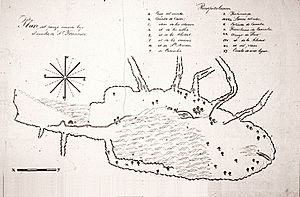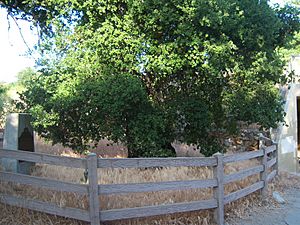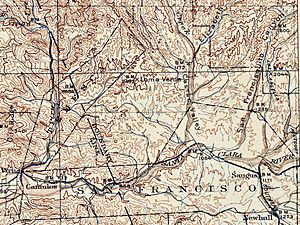Rancho San Francisco facts for kids
Quick facts for kids Rancho San Francisco |
|
|---|---|

1843 Map of Rancho San Francisco
|
|
| Location | Northwestern Los Angeles County and eastern Ventura County, California |
| Area | 48,612 acres (19,673 ha) |
| Official name: Rancho San Francisco | |
| Reference no. | 556 |
| Official name: Oak of the Golden Dream | |
| Reference no. | 168 |
Rancho San Francisco was a very large piece of land given by the government in what is now northwestern Los Angeles County and eastern Ventura County, California. This land grant covered about 48,612 acres. It was given by Governor Juan B. Alvarado to Antonio del Valle, a Mexican army officer. He received it because of his important service to Alta California, which was then part of Mexico. This rancho is not connected to the city of San Francisco.
This rancho is famous for being the place where gold was first widely found in Southern California. This happened in 1842 in Placerita Canyon. A big part of the city of Santa Clarita today sits on what used to be Rancho San Francisco. The main building of the rancho, called an adobe, and the spot where gold was found (now called the "Oak of the Golden Dream") are important California Historical Landmarks. The rancho also included parts of the San Gabriel, Santa Susana, Topatopa, and Sierra Pelona Mountain ranges.
Contents
Early History of Rancho San Francisco
After Mission San Fernando Rey de España was built in 1797, its leaders needed more land. They wanted to grow crops and raise animals. So, they looked north to the Santa Clarita Valley to set up their estancia, which was like a mission farm. The Tataviam people who lived there were moved to the Mission. There, they were taught new ways of life and worked for the Mission. The Estancia de San Francisco Xavier was built in 1804. It was located where Castaic Creek and the Santa Clara River meet.
After Mexico won its independence from Spain, the missions were no longer controlled by the church. The Mexican government took their land. In 1834, Lieutenant Antonio del Valle was asked to list everything the Mission San Fernando owned. The rancho was supposed to go back to the Tataviam people. But Governor Alvarado gave it to his friend Del Valle instead on January 22, 1839. The Del Valle family then moved into the old estancia buildings, which were near what is now Castaic.
Del Valle passed away in 1841. Before he died, he tried to make up with his son, Ygnacio. He wrote a letter offering him the entire rancho as his inheritance. But Del Valle died before his son got the letter. Ygnacio did return and took over the land. However, after a legal case, the property was divided with his stepmother.
Gold Discovery in Los Angeles Area
On March 9, 1842, a man named Francisco Lopez was resting under an oak tree. This was in Placerita Canyon. He had a dream that he was floating on a pool of gold. When he woke up, he pulled some wild onions from the ground. He was amazed to find small pieces of gold stuck to their roots! Lopez was not just a farmer who got lucky. He had studied mineralogy at the University of Mexico. He had been actively looking for gold.
Some evidence suggests gold had been found in the area about 30 years before. But Lopez's discovery was the first one that became widely known. This started a small gold rush in the area. About 2,000 people, mostly from the Mexican state of Sonora, came to Rancho San Francisco to mine for gold. This was much smaller than the famous 1849 California Gold Rush.
News of this gold discovery mostly stayed within Mexican territory. During the Mexican–American War, Del Valle destroyed the mine. He did this to stop the United States from taking control of it. The oak tree where Lopez found the gold is now called the "Oak of the Golden Dream." It is recognized as California Historic Landmark #168.
Later History of the Rancho
The Treaty of Guadalupe Hidalgo ended the Mexican–American War. This treaty said that land titles held by people in the land Mexico gave up would be respected. Jacoba Feliz, Antonio del Valle's second wife, went to court to gain control of Rancho San Francisco. She won her case in 1857. Ygnacio Del Valle received the western part of the rancho, about 13,599 acres. Jacoba Feliz (now Salazár) took 21,307 acres. Her six children each received 4,684 acres.
Sadly, Southern California faced severe floods around this time. Ranchers had to borrow money by putting their properties up as collateral. This helped them survive when they couldn't produce food or fix damages. Feliz borrowed money from William Wolfskill. He returned some of her land to Del Valle in exchange for Del Valle paying off her debts. After the floods came droughts, which made things even harder for the ranchers. Finally, in 1862, Del Valle had to sell most of his land to oil investors. He only kept his Rancho Camulos. The oil investors couldn't find any oil. Rancho San Francisco eventually ended up with Henry Newhall. His name is now well-known in the Santa Clarita Valley area.
Newhall allowed the Southern Pacific Railroad to build a rail line to Los Angeles. He also sold them a piece of land. A new town grew there, which the company named after him: Newhall. Another town grew around the train station. Newhall named it Saugus, after his hometown.
After Henry Newhall died in 1882, his family created the Newhall Land and Farming Company. This company managed the lands. In 1936, Atholl McBean, who was Newhall's grandson-in-law, found oil on the property. He then changed the name to Newhall Ranch.
Historic Designations
California Historical Landmark No. 556 Rancho San Francisco Adobe The marker says:
NO. 556 RANCHO SAN FRANCISCO – About half a mile south of this spot was the adobe headquarters of Rancho San Francisco. It was first built around 1804 as a granary for Mission San Fernando. The rancho was given to Antonio de Valle in 1839. Here, in January 1850, William Lewis Manly and John Rogers got supplies and animals. They used these to rescue their friends who were part of a group looking for gold. This group was stuck and starving in Death Valley, about 250 miles to the northeast.
Placerita Canyon State Park – California Historical Landmark No. 168 Oak of the Golden Dream: This is where Francisco Lopez found gold. The marker says:
NO. 168 OAK OF THE GOLDEN DREAM – Francisco López made California's first proven gold discovery on March 9, 1842. While gathering wild onions near an oak tree in Placerita Canyon, he found gold pieces clinging to the roots of the bulbs. Miners from Sonora worked the San Fernando placers and nearby San Feliciano Canyon. They used methods like panning, sluicing, and dry washing. Lopez's discovery happened six years before James Marshall found gold at Sutter's Mill.



